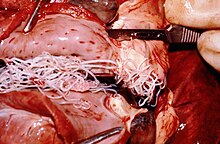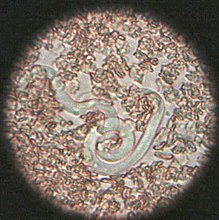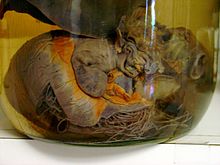Heartworm disease
The heartworm disease ( cardiovascular dirofilariosis ) is a parasitic disease of dogs and other dog-like , rarely, cats . It is difficult to treat and is often fatal. It occurs mainly in North and Central America , but is also widespread in the Mediterranean (especially in Italy , Greece , southern France , Portugal and the Canary Islands ) and the tropical and subtropical areas, which is why it is also classified as a " Mediterranean disease " . Individual cases were also observed in Hungary and Ticino , which is why dogs in particular are at risk of infection when traveling to these regions.
Pathogen
The causative agent of dirofilariasis is the filarial species Dirofilaria immitis . These parasites are necessarily divalent. A part of the development cycle, from larval stage 1 to 3 ( microfilariae ), takes place in mosquitoes . So far, more than 70 mosquito species have been identified as carriers, but not the species native to Central Europe. The mosquito transfers these microfilariae to the host during the act of sucking.
In the subcutaneous tissue, development to larval stage 4 takes place within 2 months. These larvae 4 migrate through the muscles into the blood vessels and develop into adult heartworms ( macrofilariae ) after a further two to three months . The adult heartworms are about 1 mm thick and 20 to 30 cm long and mainly settle in the pulmonary trunk , and if more severe, also in the right half of the heart and the sections of the vena cava near the heart . About six months after infection, the females again form microfilariae (larva 1), which get into smaller blood vessels with the blood and are possibly taken up again by mosquitoes when they suckle. Microfilariae can circulate in the bloodstream for up to three years.
The disease occurs mainly in dogs in the endemic areas. Cats are affected much less often, the prevalence is only about 10% that of dogs. Even foxes , seals and rarely people can become ill.
Infection with the related species Dirofilaria repens is restricted to the skin and rarely causes clinical symptoms.
Clinical picture
With the development of the mature worms, i.e. only about 6 months after the infection, the infected animals show a reduced performance, depending on the degree of infection, and tire quickly. Right heart failure develops with overload and enlargement of the right side of the heart ( cor pulmonale ) with shortness of breath, coughing and the formation of edema . Liver and kidney failure can also occur as a result of heart failure . In cats, thromboembolism of the pulmonary arteries can lead to dyspnoea and death.
diagnosis
The diagnosis can be made through a microscopic examination of capillary blood or a Knott test for microfilariae, but the reliability of detection is only about 75%. The antigen detection in the serum is also only certain six months after the infection, with the release of microfilariae. A rapid immunochromatographic test ( Speed DIRO ) is available for detection .
therapy
The treatment is complicated because heartworms though for drugs such as diethylcarbamazine or Melarsamin are in principle receptive but one with stronger infestation embolism or severe anaphylactic reaction may occur as a result of the massive dying of microfilariae. The treatment is therefore usually combined with acetylsalicylic acid and, in the case of severe infestation, with antihistamines . Treatment with levamisole can also cause serious side effects ( bleeding , haemolytic anemia ) in dogs . Surgical removal of heartworms is also risky and only possible in specialized clinics.
Because of the problems with therapy, prevention is even more important. Treatment with ivermectin , moxidectin , selamectin , milbemycin oxime, or lufenuron before you go on vacation can prevent infection. In Mississippi -Delta heartworms are increasingly isolated, which respond to any of these drugs more. Because of these resistances, it is not advisable to use these active ingredients for a gradual killing ( slow kill ) of heartworms, as has been recommended for many years to prevent anaphylactic reactions. Measures should also be taken to minimize the exposure of dogs to mosquitoes.
Web links
- R. Edelhofer: Holidays with the dog - souvenirs that nobody wants. Article of the VU Vienna with pictures


